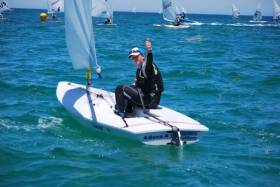Displaying items by tag: 29er Worlds
Johnny Durcan sailed in Crosshaven on Thursday night (10 August) for the first time since his dramatic capsize at the 29er Worlds in which he became trapped under his skiff.
As previously reported on Afloat.ie, the Royal Cork’s hottest youth sailing prospect almost drowned in the incident at Long Beach, California last weekend.
It was only the quick action of his fellow competitors that saved his life, he said.
The 17-year-old has since taken to the Facebook account he shares with his brother Harry to pay tribute to two sailors in particular, Australia’s Simon Hoffman and Spain’s Santiago Alegre.
Eighteen-year-old Hoffman, a devout Christian, believes it was God’s plan that saw him jump into the water from his boat without a second thought to try to save his trapped friend, as he told The Australian.
The New South Wales sailor was joined by Catalan racer Alegre in attempting to pull Johnny free from beneath the upturned skiff.
The pair finally succeeded after a few minutes, but then faced a difficult swim to a nearby motorboat with a lifeless Johnny.
“I still thought he was dead, because his eyes were still open, there was no breathing and he was limp,” Hoffman said after he and Alegre had attempted CPR for some time to no avail.
But the duo persevered till they saw a blink in his right eye, then a slight breath through his nose — small but vital signs of life.
Johnny Durcan has since made a full recovery, returning to the water just days after his life-threatening ordeal.
And he says he plans to record a video telling his side of the story on his return from the Laser Radial Youth Worlds in the Netherlands next week.
The full story is behind a paywall, so you may or may not be able to access it, without subscribing but here's some excerpts:
Suffice to say that Mr Hoffman had recently received "intensive first-aid training as part of his bid to become a fully-fledged sailing coach. He took charge, and likely saved his Irish mate's life who, after CPR administered by Hoffman and Santiago, was revived. A Coast Guard boat arrived and rushed Durcan to a Long Beach hospital where he was admitted and recovered, and was later visited by Hoffman.
Two other revealing excerpts from the article:
“Some of the other boats yelled out ‘I think he needs help’ as they sailed past,” Hoffman said. “I found that really weird.
From his hospital bed, Durcan wasted no time in sending a message to the general email address of Australian Sailing to have Hoffman’s efforts officially acknowledged. “Simon Hoffman quite literally saved my life yesterday at the 29er worlds, and is the reason I’m alive to write this from hospital,” he wrote. “Maybe I can nominate him for some sort of special award.” Australian Sailing president Matt Allen said yesterday: “Simon’s efforts show great bravery. We will do everything we can to ensure he is recognised. Everybody is so proud.” Durcan and Hoffman, both safely back home, now have a lifelong bond.
























































